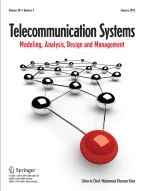Abstract
Ad-hoc and sensor networks are a well-studied area which gained a lot of attention in the research in the last decades. Two of the problems of battery-powered radio devices are limited transmitter power and finite amount of energy. This paper continues the path opened by the development of a new technology for radio communication which allows cluster communication beyond the horizon of each individual transmitter and the distribution of power need among the modules forming a cluster. This in terms decreases the average power need per device and contributes to a longer lifetime of the entire network.
Similar content being viewed by others
Explore related subjects
Discover the latest articles, news and stories from top researchers in related subjects.References
Balanis, C. (2005). Antenna theory, analysis and design (pp. 1003–1014).
Chen, Z. N., & Luk, K. M. (2009). Antennas for base stations in wireless communications (Vol. 1, pp. 1–3)
Gomez, J., Mendez, L. A., Rangel, A., & Campbell, A. T. (2010). PCQoS: power controlled QoS tuning for wireless ad hoc networks. Telecommunication Systems, 47, 303–321.
Kivanc-Tureli, D., Nehaben, P., & Tureli, U. (2007). Effective channel utilization using the RI-BTMA protocol. In Military communications conference, MILCOM 2007 (pp. 1–7).
Langton, C. (2010). Unlocking the phase lock loop—part I. http://www.complextoreal.com/chapters/pll.pdf/.
Moucha, A., & Cerny, V. (2010). Anisotropic antenna collaborative beamforming in adhoc networks: beyond horizon communication. In Proceedings of the 6th international wireless communications and mobile computing conference, IWCMC 2010.
Moucha, A., & Gattermayer, J. (2011). Cluster discovery in phase-shift beamformed ad-hoc and sensor networks. In Proceedings of the 7th international wireless communications and mobile computing conference, IWCMC 2011.
Moucha, A., Cerny, V., & Kubr, J. (2011). Distributed phase-shift beamformed power balancing in ad-hoc and sensor networks. In Proceedings of the international conference on telecommunication systems—modeling and analysis, ICTSM 2011.
Moucha, A., Cerny, V., & Kubr, J. (2011). Distributed system for beamforming. Patent Application, Reg. No. 2011-25254 / 2011-785.
Sundaresan, K., & Sivakumar, R. (2006). Ad hoc networks with heterogeneous smart antennas: performance analysis and protocols: research articles. Wireless Communications and Mobile Computing, 6(7), 893–916. Wireless Ad Hoc Networks: Technologies and Challenges.
Trivino-Cabrera, A., Garcia-de-la-Nava, J., Casilari, E., & Gonzalez-Canete, F. J. (2008). Application of path duration study in multihop ad hoc networks. Telecommunication Systems, 38, 3–9.
Wattenhofer, R., & Zollinger, A. (2004). XTC: a practical topology control algorithm for ad-hoc networks. In Parallel and distributed processing symposium 2004.
Wenning, B. L., Pesch, D., Timm-Giel, A., & Gorg, C. (2010). Environmental monitoring aware routing: making environmental sensor networks more robust. Telecommunication Systems, 43, 3–11.
Acknowledgements
The research reported in this paper has been supported by the Ministry of Education, Youth and Sports of the Czech Republic under the research program MSM 6840770014 and by the Grant Agency of the Czech Technical University in Prague, grant No. SGS11/158/OHK3/3T/13.
Author information
Authors and Affiliations
Corresponding author
Rights and permissions
About this article
Cite this article
Moucha, A.M., Cerny, V., Kubr, J. et al. Distributed phase-shift beamforming power balancing in ad-hoc and sensor networks. Telecommun Syst 57, 367–377 (2014). https://doi.org/10.1007/s11235-013-9839-2
Published:
Issue Date:
DOI: https://doi.org/10.1007/s11235-013-9839-2
